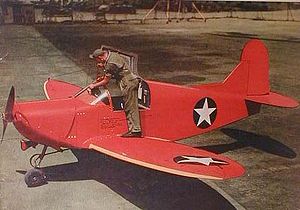Culver Cadet Videos
|
Loading...
|
|
Culver Cadet
Cadet / PQ-8

Picture - Culver PQ-8A c. 1941
Role: Two-seat Light Monoplane
Manufacturer: Culver Aircraft Company
Designed by: Albert Mooney
First flight: 1939
Number built: 600+
Variants: PQ-14 Cadet
The Culver Cadet was an American two-seat light monoplane aircraft, and later a radio-controlled drone, produced by the Culver Aircraft Company.
Design and development
The aircraft designer Al Mooney developed an improved version of the Culver Dart, to provide improved performance with a smaller engine. Originally designated the Culver Model L the prototype first flew on 2 December 1939. The aircraft was named the Culver Cadet. Although similar to the previous Dart the Cadet had a semi-monocoque fuselage instead of welded-steel-tube and a retractable tailwheel undercarriage. The first variant (the Cadet LCA) was powered by a 75 hp (56 kW) Continental A75-8 four-cylinder horizontally-opposed piston engine. The 1941 version (the Cadet LFA) introduced a number of refinements and more equipment, and was fitted with an 90 hp (67 kW) Franklin engine. Production was brought to an end after the United States entered World War II in December 1941, but the Cadet had found a new role.
The Cadet was one of six models that Al Mooney designed during his eight years at Culver. He would leave to found Mooney Aircraft.
Operational history
In 1940 the Cadet LCA was selected by the United States Army Air Corps as being suitable for use as a radio-controlled target. The first aircraft was designated the Culver A-8 (later the XPQ-8) and was based on the Cadet LFA but had fixed tricycle landing gear. After successful tests a production order for 200 was placed, and designated the PQ-8, later another 200 were ordered with a more powerful engine as the PQ-8A. In late 1941 the United States Navy acquired a PQ-8A for evaluation and then ordered 200 in 1941 as the TDC-2. An enlarged and improved version was later built as the Culver PQ-14.
Variants
Cadet LCA
Initial production version powered by a 75 hp (56 kW) Continental A75-8.
Cadet LFA
Improved variant with an 80 hp (60 kW) Franklin 4AC-176-F3, -D2, or -D3 engine, and a full electrical system and engine starter.
Cadet LFA-90
Limited edition variant with a 90 hp (67 kW) Franklin 4AC-199-E3 engine.
LAR (Army A-8)
Initial designation of military radio-controlled drone version, later redesignated PQ-8.
LAR-90 (Army PQ-8)
Initial production military drone version, 200 built.
PQ-8A
PQ-8 powered by a 125 hp (93 kW) Lycoming O-290 engine, redesignated Q-8A in 1948, 200 built.
Q-8A
PQ-8A redesignated in 1948.
TDC-1
One PQ-8 for evaluation by the United States Navy.
TDC-2
Production version of the PQ-8A for the Navy, 200 built.
Operators
United States
United States Army Air Corps
United States Navy
Survivors
The Smithsonian National Air and Space Museum owns a Culver TD2C-1 Serial No. 120035 used by the United States Navy.
Specifications (Cadet LFA)
General characteristics
Crew: 2
Length: 17 ft 8 in (5.38 m)
Wingspan: 27 ft 0 in (8.23 m)
Height: 5 ft 6 in (1.68 m)
Wing area: 120 ft² (11.15 m²)
Empty weight: 806 lb (366 kg)
Max takeoff weight: 1,305 lb (592 kg)
Powerplant: 1x— Franklin 4AC-176-F3 flat-four piston, 80 hp (60 kw)
Performance
Maximum speed: 142 mph (229 km/h)
Range: 500 miles (805 km)
Service ceiling: 17,000 ft (5180 m)
Related development
PQ-14 Cadet
Comparable aircraft
Culver PQ-14 Cadet
Bibliography
The Illustrated Encyclopedia of Aircraft (Part Work 1982-1985). London: Orbis Publishing, 1985.
Mondey, David. American Aircraft of World War II (Hamlyn Concise Guide). London: Bounty Books, 2006. ISBN 978-0-7537-1461-4.
Mormillo, Frank B. "Defenceless Warrior: Culver's PQ-14 Drone." Air Enthusiast, Issue 93, May/June 2001.
Simpson, R.W. Airlife's General Aviation. Shrewsbury, UK: Airlife Publications. 1991. ISBN 1-85310-194-X.
Culver Cadet Pictures
Living Warbirds: The best warbirds DVD series.
Source: WikiPedia